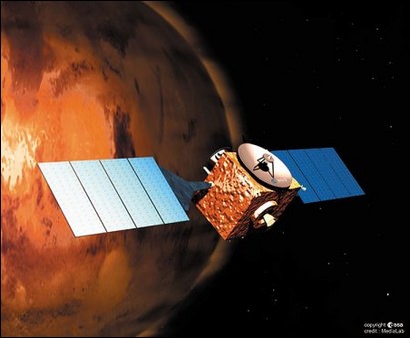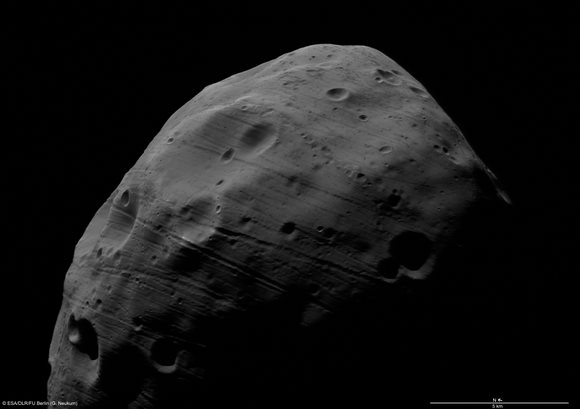[/caption]
Mars Express will skim over the surface of Mars’ largest moon on Wednesday, making the closest flyby of Phobos by any spacecraft. Passing at just 67 km above the surface, precise radio tracking will allow researchers to virtually peer inside the mysterious moon. You can follow the flyby in “real time,” — allowing for the current 6 minute and 30 second light time delay from Mars (13 minutes round trip) – on the Mars Express blog. The flyby will take place on March 3, at 20:55 GMT.
The straight-line distance between Mars Express and Earth is now about 116 million km.
Flying by at such close range, Mars Express will be pulled ‘off-course’ by the gravitational field of Phobos. This will amount to no more than a few millimeters every second and will not affect the mission in any way. However, to the tracking teams on Earth, it will allow a unique look inside the moon to see how its mass is distributed throughout. Phobos’ shape is 27 km × 22 km × 19 km, and has a mass of 1.072 x 1016 kg, or about one-billionth the mass of Earth.
To make the very sensitive measurements of Phobos’ interior, all the data signals from the spacecraft will be turned off. The only thing that the ground stations will listen out for is the ‘carrier signal’ – the pure radio signal that is normally modulated to carry data.
With no data on the carrier signal, the only thing that can modulate the signal is any change in its frequency caused by Phobos tugging the spacecraft. The changes will amount to variations of just one part in a trillion, and are a manifestation of the Doppler effect – the same effect that causes an ambulance siren to change pitch as it zooms past.
Two dress rehearsals for this exacting operation have already taken place, allowing ground station personnel and spacecraft controllers to practice.
Originally, the closest flyby was going to only 50 km above the surface, but a slight ‘over performance’ during a maneuver last week had put the spacecraft on a trajectory that included an occultation by Phobos. This meant that Mars Express would pass behind Phobos as seen from Earth. As this would jeopardize the tracking measurements, it was decided to perform another maneuver to position the flyby at a slightly higher altitude than originally planned.

Mars Express will zoom past Phobos seven more times after Wednesday’s closest approach. The first planned High Resolution Stereo Camera (HRSC) observations will be on March 7, when the spacecraft will be at 107 km altitude above Phobos.
In addition to the tracking experiment, known as MaRS for Mars Radio Science, the MARSIS radar has already been probing the subsurface of Phobos with radar beams. “We have performed a preliminary processing of the data and the Phobos signature is evident in almost all the data set,” says Andrea Cicchetti, Italian Institute of Physics of Interplanetary Space, Rome, and one of the MARSIS team.
Source: ESA


Does anyone know the origin of the (almost parallel) linear features on the surface of Phobos?
I think the straight lines look like furrows plowed into the surface by debris expelled from impacts being drawn back to the moon by its gravity. Their orbits decline until they are skimming the surface, upon contact they begin to roll across the surface.
That is my slightly educated guess.
Wow – a space related event that I can follow that actually occurs at a reasonable time of day in Sydney. Nice change to the usual ritual of mixing up some strong coffee and staying up until ridiculous hours of the early morning…
“It’s hollow inside”
I wondered about those lines as well. I have no idea where they come from, it looks as if Phobos is shrink wrapped. This ESA test is similar to how satellite geodesy is used to map the matter distribution of Earth.
LC
@ lotusface
Interesting but, there doesn’t seem to be evidence of any of that debris (from this view) on the surface. Interesting also that (again, from this view) the lines follow contour of the surface topology and it seems the cratering/bombardment took place prior to the etching as they flow into and out of the craters.
I sure hope the Russians and collaborators load up on the science instruments on their Phobos-Grunt mission. This looks tantalizing! Take the time to blow this image up; it’s fascinating.
Anxiously awaiting data…